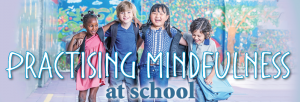Practicing mindfulness at school

Do you have students that have difficulty focusing on given tasks, that exhibit signs of anxiety or depression, or have difficulty regulating their emotions? While these students stand out in our mind, all students need to develop mindfulness and coping strategies to self-regulate their thoughts and actions, regardless of the severity or diagnosis of a mental health condition.
Developing mindfulness in schools
- Mindfulness in Schools: Mindfulness in Schools Project (MiSP) is a charity whose aim is to inform, create, train and support the teaching of secular mindfulness to young people and those who care for them. It is comprised of 16 core 15-minute lesson plans to be presented twice a week over 9 weeks.
- The Mindfulness Foundation: The Mindfulness Foundation is collaborating with vendors of mindfulness training and innovative mobile and social suppliers to create transformative cognitive School System Mindfulness Applications.
- Meditation in Schools: This site provides tips for teachers to develop mindfulness in their own lives as well as their classrooms. Start to bring mindfulness, meditation and calm into your students/child’s life with these great free resources.
Related childrens literature
- Mindful movements: ten exercises for well-being by Thich Nhat Hanh
- Master of mindfulness: how to be your own superhero in times of stress by Laurie Grossman
- Sitting still like a frog: mindfulness exercises for kids (and their parents) by Eline Snel
- Mindful monkey, Happy panda by Lauren Alderfer
- Peaceful piggy meditation by Kerry Lee Maclean
- Peaceful piggy yoga by Kerry Lee Maclean
- Meditation is an open sky: Mindfulness for kids by Whitney Stewart
- You are a lion! And other fun yoga poses by Tae-Eun Yoo
- Take the time: Mindfulness for kids by Maud Roegiers
- A boy and a bear: The children’s relaxation book by Lori Lite
Developing mindfulness in the classroom has many psychological and physical health benefits to all students, including reducing stress levels, reducing tiredness through better sleep patterns and reducing irritability. It allows students to increase their emotional stability, their ability to effectively manage problems and their ability to learn and remember information. Therefore, as educators, it is important we give students the time to learn and practise mindfulness in our classrooms.
For more great health resources, check out Primary PSHE, Conflict Resolution, Teaching Values Toolkit, Lifestyle Choices and Total Health.
